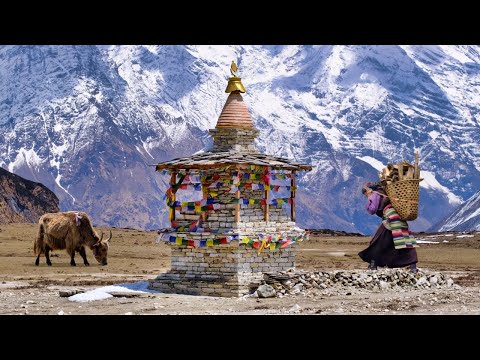
Nestled in the remote reaches of the Nepal Himalaya lies the Tsum Valley, a region so pristine and secluded that it was only opened to trekkers in 2008. This hidden valley, where the rugged trails of Nepal meet the mystic serenity of Tibet, offers more than just a physical journey through its landscapes; it is a voyage into the heart of centuries-old cultures and breathtaking natural beauty.
#### Geographic and Cultural Overview
The Tsum Valley is situated in northern Gorkha District, close to the Tibetan border. The region is part of the larger Manaslu Conservation Area and is dominated by majestic peaks, deep gorges, hamlets perched on mountain ridges, and ancient relics. The valley runs along the powerful Budhi Gandaki River as it carves its way through the mountains.
Culturally, Tsum Valley is predominantly Tibetan Buddhist with strong historical ties to Tibet. This influence is evident in daily life here; local villagers speak a dialect similar to Tibetan, monasteries date back several hundred years, prayer flags flutter with every gust of wind, and mani walls (stone walls with Buddhist prayers inscribed) line frequently traveled paths.
#### Trekking Through Time
Trekking in Tsum Valley often feels like stepping back in time. The trek traditionally starts from Arughat or Soti Khola, several hours’ drive from Kathmandu. It follows upstream alongside Budhi Gandaki River through dense forests and terraced fields before entering the valley proper. As trekkers ascend into this ‘hidden valley’, they are greeted with views that stretch out to include Ganesh Himal to the south and Sringi Himal to North.
The journey usually takes about two weeks round trip from Kathmandu but can vary depending on individual pace and interest areas within the valley such as Chhokangparo or Mu Gompa – an ancient monastery at an altitude of over 3,700 meters which serves as one of the valley’s spiritual centers.
#### Spiritual Sojourns and Cultural Immersion
A significant aspect of trekking in Tsum Valley is encountering its rich tapestry of cultural heritage. Villages like Chumling, Chhokangparo, Nile, and Rachen Gompa house ancient monasteries that play a pivotal role in local life. Trekkers often get opportunities to witness local festivals such as Dhacyhang (New Year) or Saka Dawa (honoring Buddha’s life), which provide deeper insights into local customs and community spirit.
Monasteries like Rachen Gompa are not just religious sites but also act as community centers where people gather for education and decision-making purposes. Interaction with monks who have devoted their lives to spiritual studies adds another layer of richness to this trekking experience.
#### Flora and Fauna
The ecological diversity of Tsum Valley also makes it a fascinating destination for nature enthusiasts. As you move upwards through different forest types—from subtropical jungles at lower altitudes to alpine forests higher up—there’s a noticeable shift in vegetation. The area is home to endangered species like the Himalayan Thar or Snow Leopard although sightings are rare due to their elusive nature.
#### Sustainable Travel: Preserving Serenity
Since being opened for tourism relatively recently compared with other parts of Nepal such as Everest or Annapurna regions; preserving natural beauty while promoting sustainable tourism has become crucial for Tsum Valley’s future prospects. Efforts by local communities supported by conservational organizations aim at ecological conservation balancing increasing tourist traffic ensuring that trekking remains responsible ethically environmentally friendly manner.
